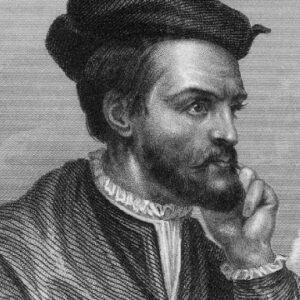Jacques Cartier is credited with claiming what is now Canada for France in the 16th century. He is also credited with naming the region, referring to the territory around what is now Quebec City with the term ‘Canada,’ which is derived from the Huron-Iroquois word ‘kanata,’ which means a community or settlement. Cartier was also the first European to map and characterize the Gulf of Saint Lawrence and the Saint Lawrence River’s coasts. His survey of the area around the Saint Lawrence River led to France claiming the territories that would later become Canada. Before he became a famous explorer, little is known about Cartier’s life. He is thought to have accompanied Giovanni da Verrazzano on unofficial travels sponsored by the King of France when he was a young man. These unofficial excursions most likely provided him with vital navigational expertise, as he was afterward commissioned by the king to embark on journeys with the goal of discovering a western path to Asia. On his first expedition, he discovered Prince Edward Island, and the king was so impressed with his exploration skills that he dispatched him on several voyages in the future, during which he explored and claimed modern-day Canada for France.
Childhood and Adolescence
On December 31, 1491, Jacques Cartier was born in Saint-Malo, a port on Brittany’s northwestern coast. His early years are shrouded in mystery.
It is unknown how he learned to navigate, however, it is widely assumed that he accompanied Giovanni da Verrazzano on unauthorized excursions sponsored by King Louis XIV of France in 1524.
A Later Years
In 1534, Bishop of Saint-Malo and Abbot of Mont-Saint-Michel Jean le Veneur brought Cartier to King Francis I. By that time, he had gained some navigational skills, and the king had asked him to lead the official expedition to North America.
Cartier set sail on April 20, 1534, with a commission from the king to “find various islands and lands where it is reported that a large quantity of gold and other precious goods are to be found.”
He explored sections of Newfoundland and the Gulf of Saint Lawrence during this journey. On the north side of Chaleur Bay, he met aboriginal people and did some business with them. In September 1534, he also abducted two people from the Saint Lawrence Iroquoian tribe and transported them to France.
Cartier informed the king of everything he had discovered. The king was so delighted with his findings that the next year he ordered him on another journey. With three ships, 110 soldiers, and two Iroquoian captives as guides, he set off on his second voyage.
The expedition traversed the Saint Lawrence, reaching Quebec and establishing a base. Then Cartier sailed downriver to modern-day Montreal, where the Iroquois greeted him. He learned about more rivers that headed further west, where he could get gold, silver, copper, and spices, from the inhabitants.
Cartier and other explorers planned to continue further west in quest of gold, silver, and spices, but winter intervened and prevented them from doing so.
They had to put their future plans on hold for a while because the winter was harsher than they had anticipated. Several of Cartier’s men died of diseases throughout the winter, and to make matters worse, the explorers’ formerly friendly ties with the Indians deteriorated.
Cartier captured three Iroquois chiefs and sailed for France as spring arrived and the rivers began to thaw. Then he told the king what he had discovered about the regions that were richer in the interior of the lands they had examined.
For a few years, the monarch was unable to send out any expeditions due to the war in France. The monarch instructed Jacques Cartier to return to Canada and begin the colonization process as the political situation in France improved.
In May 1541, he set sail on his third expedition, this time with five ships, in search of the “Kingdom of Saguenay” and its riches, as well as establishing a permanent settlement along the Saint Lawrence River.
Cartier and his soldiers arrived in Quebec and established camp. They discovered a plethora of what they assumed were gold and diamonds there. Cartier zealously collected what he thought were treasures, then abandoned the base and returned to France to sell the loot.
Other colonists despatched by the king were on their way to Canada at the time and were expected to assist Cartier in founding a community. Cartier, on the other hand, did not wait for them and fled to France.
When he returned to his homeland, he was shocked to learn that the “diamonds” and “gold” he had diligently collected were actually worthless quartz crystals and iron pyrites.
He was never dispatched on another commissioned journey after losing favor with the king due to his careless actions.
Jacques Cartier’s Major Projects
Jacques Cartier christened the region “The Country of Canadas” after exploring the Gulf of Saint Lawrence and the Saint Lawrence River’s coasts. Despite the fact that Cartier did not participate in the colonization of Canada, his vast expeditions established the groundwork for France’s later claims to the region.
Personal History and Legacy
In the year 1520, Jacques Cartier married Mary Catherine des Branches. His bride came from a well-known family.
During an outbreak, he died on September 1, 1557. He was 65 years old at the time.
Estimated Net worth
Jacques is one of the wealthiest explorers and one of the most well-known. Jacques Cartier’s net worth is estimated to be $85 million.


